
The Natural Georgia Series: The Chattahoochee River

 |
The Natural Georgia Series: The Chattahoochee River |
 |
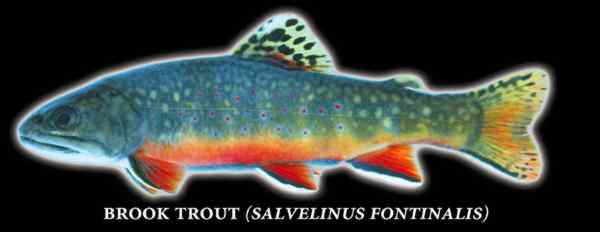
Nestled just south of Helen was the pristine trout stream we had traveled over 75 miles from Atlanta to see. The scenery was worth the trip. This 1.5-mile section of stream meandering among Georgia's southern Appalachians was just as charming as a first-timer would expect. The clear, cool mountain water moved swiftly across the boulders and pebbles of varying sizes that lay in its winding path. The crisp mountain air encouraged deep breaths, as we escaped from the hustle and bustle of the city to relax in the serenity of the quiet woods that surrounded the small mountain stream known as the Chattahoochee.
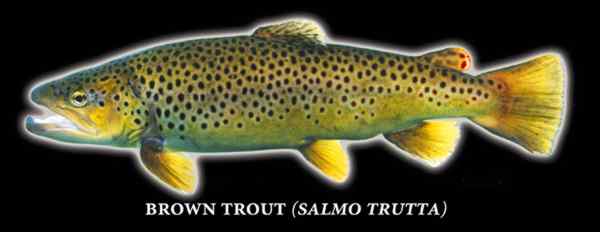
The Chattahoochee is one of the most highly regarded trout streams in the state and the Southeast for that matter. It was turned into a trout stream with the development of Buford Dam and the creation of Lake Lanier. Prior to the development of the dam, the river was a warm-water fishery. Because the river was changed to a cold-water stream, cold-water fisheries (rainbow and brown trout) were soon stocked in the watershed. These popular sport fish draw in thousands of anglers annually to the river's remote areas in north Georgia and to its urban section in the metro Atlanta area.
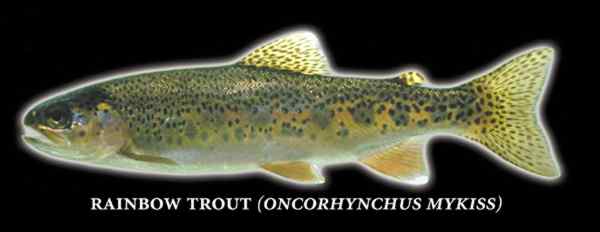
In the headwaters of the Chattahoochee some of the better areas to fish are on private land, such as the section leased by Unicoi Outfitters that provides a unique, private trout fishing experience on the Chattahoochee. My experience that day with guide Jimmy Harris, owner of the outfitter, provided an inside look at trout in the Chattahoochee, particularly the fish found in the upper reaches of the river.
The trout population in the Unicoi Outfitters section of the 'Hooch (as some call the Chattahoochee) was certainly impressive. I know this because I could see the numerous fish fending off my hook. According to Harris, the average fish caught is 3-4 pounds, but a lot of fish pulled from the river range 7-8 pounds.
Nice-sized trout aren't limited to just that section of the river, however. The Chattahoochee's credit as an excellent trout fishery is due more to the trout population below Buford Dam than above it.
In river guide Chris Scalley's opinion, the Chattahoochee's tailwaters offer the best trout fishery in Georgia.
"There are few other similar resources in the Southeast. In fact, the Chattahoochee is ranked in the top 100 most popular streams by Trout Unlimited," said Scalley who leads fly-fishing trips on the Chattahoochee in the Atlanta area.
Surprisingly to some the tailwaters of the Chattahoochee receives the majority of fishing pressure, despite its polluted condition in and below Atlanta. According to Jimmy Jacobs, author of the book Trout Fishing In North Georgia, 60-70 percent of fishing on the Chattahoochee occurs below Buford Dam. The portion of the Chattahoochee that lies above Lake Lanier is too similar to other mountain streams to draw a large number of anglers. It doesn't stand out like the Chattahoochee's tailwaters, which is believed to receive more fishing pressure than any other trout stream in the state.
This has not always been the case, however. The trout fishery today is much better than it was back in the early 1970s, says Jacobs, who began fly-fishing the Chattahoochee at about that time. "There are more opportunities, more fishing, more variety, and better management now," he says.
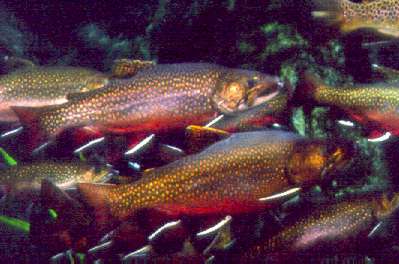 Twenty-something
years ago, when the trout fishery was being developed, management of the river
was very different. Jacobs remembers a trout checking station located in north
Georgia near the Robertstown Bridge and run by the Georgia Department of Natural
Resources (DNR) where anglers had to check in before fishing the river. Fisheries
managers limited fishing to just two or three days a week in an effort to suppress
the amount of fishing pressure while they built up the trout fishery. Today,
the trout fishery is large enough to necessitate year-round access on several
streams, a far cry from just over two decades ago.
Twenty-something
years ago, when the trout fishery was being developed, management of the river
was very different. Jacobs remembers a trout checking station located in north
Georgia near the Robertstown Bridge and run by the Georgia Department of Natural
Resources (DNR) where anglers had to check in before fishing the river. Fisheries
managers limited fishing to just two or three days a week in an effort to suppress
the amount of fishing pressure while they built up the trout fishery. Today,
the trout fishery is large enough to necessitate year-round access on several
streams, a far cry from just over two decades ago.
The first trout stocked in the river, however, were not deposited by the state wildlife agency, then called the Game and Fish Commission, but by a group of avid fishermen with the Atlanta Chapter of the Izaak Walton League, who later formed the first Trout Unlimited chapter in the state. These anglers wanted to see trout in the river, and after not getting any cooperation from the state decided to take on the project themselves. In 1962 they pooled $2,500 and bought 12,500 rainbow trout fingerlings sizes 2 to 4 inches long from a trout farm in North Carolina. The owner there was so impressed by the project that he threw in another 2,500 brown trout fingerlings. The fish were released after dark in the shoals of the river approximately 1 mile south of Old Jones Bridge in Norcross. The trout survived and within a year had grown to 12-14 inches, a growth rate of nearly 1 inch per month.
The undercover, and seemingly illegal, initial stocking of trout in the Chattahoochee jump started what is now one of the best trout fisheries in the state. Currently, a total of 1.1 million trout are stocked statewide each year by the DNR. Nearly one quarter of these fish are stocked on the Chattahoochee below Buford Dam. The fish stocked are limited to browns and rainbows. Brook trout, the only native trout to Georgia, were stocked many years ago; however, hatchery brooks are not interchangeable with existing native populations of brooks. Brooks are also much more difficult to raise and are no longer bred for stocking purposes.
No other Georgia stream can hold a candle to the Chattahoochee's trout fishery. Trout occur as far south as Peachtree Creek, downstream of which treated wastewater from the city of Atlanta halts the trout's southern migration.
Numerous other streams in north Georgia hold a terrific wild trout resource with reproducing wild rainbows and browns in many areas.
One of the reasons the trout are so successful is that they generally have few predators, other than man. While Bull Sluice Lake, a small impoundment created from Morgan Falls Dam has produced bass and bream, these fish won't move upstream because water is too cold, protecting the small trout that would be prey. The only other fish that has had any effect on the trout fishery is the striped bass. Stripers, unlike other warm-water species, can endure cold water. While they were previously stocked in Lake Lanier, they are no longer being released because of their migratory behavior. (See striped bass sidebar.)
Trout are of the family Salmonidae, which also includes salmon. Fish in this family occur in temperate fresh and salt water in the Northern Hemisphere and have been widely introduced in North America where there are currently 39 species. All trout and salmon have a pelvic, axillary scale and an adipose fin. Most have well-developed teeth on both jaws.
Of the three trout species found in the Chattahoochee, the only native trout species is found in the higher altitudes of the Georgia mountains. Brook trout (Salvelinus fontinalis) are native to the eastern United States and Canada. Brooks found in the Chattahoochee were transplanted from other streams and are found above Helen in the headwaters of the Chattahoochee and in some tributaries, though the majority occur near Henson Creek Falls. Brooks don't coexist well with other trout so they are restricted to areas devoid of other trout species.
"The range of brook trout is limited by the fact that they don't compete well with other fish. They are found at higher elevations and in smaller streams, generally where there's a barrier falls to prevent other trout from migrating into the brooks' habitat. The typical brook trout stream is no more than a mile in length," said Lee Keefer, a DNR fisheries biologist out of the Lake Burton Hatchery.
Eastern brook trout have a more blotchy appearance along the back and dorsal fins than other trout. They can be easily identified by their characteristic bright red spots outlined in blue along their sides. When spawning, males usually develop some red to orange coloration along their lower sides. Wild trout, including brook trout, may also be distinguished by their fins. Hatchery fish tend to have deformed fins while wild fish do not.
Brook trout have generally been considered more sensitive to elements such
as acid rain. In Virginia where acid rain has been a significant problem, a
recent study has found the opposite to be true. In streams that have become
more acidic from the rain, brook trout dominate the trout population and
re-colonize areas where there were rainbows and browns before. "The brooks are
not quite as delicate as thought," said Keefer. Scientists are monitoring for
acid rain in Georgia, but it is currently not as severe of an issue as in the
middle and northern Atlantic states.
Rainbows and browns originate from other parts of the world. Rainbows are native to North America's West Coast, while brown trout were brought over from Europe and the British Isles. In the South, the range of brown and rainbow trout is limited to the Appalachian and Ozark mountains.
Brown trout (Salmo trutta) were first introduced to the U.S. in 1883. Natives to Europe and western Asia, they have olive-colored bodies with numerous orange to rusty spots on their sides. Browns are one of the most widespread salmonids in the United States.
The spawning habits of the brown trout are similar to that of the brook trout in that they both spawn in the fall. Rainbows, on the other hand, reproduce in the spring.
Rainbow trout (Oncorhynchus mykiss) have the characteristic small, black-brown spots covering their heads, backs, sides, and dorsal and tail fins. They are distinguished from browns and brooks by the red to pink colored band that runs the length of their sides. Their olive body color changes to a silvery shade on their sides, as well.
The native range for rainbows is west of the Rocky Mountains and along the Pacific coast. They are one of the most popular cold-water sport fish, and are heavily stocked in many areas. Unlike other species of trout, they are more tolerable of slightly warmer temperatures.
Rainbows in the Chattahoochee average seven to eight years old, but rarely exceed 15 inches in length, even at that age. Few rainbows can be found beyond that age range.
The size of the trout found in Georgia rivers is somewhat dependent on the size of the stream and the food base found there. For example, brook trout found up in the Chattahoochee's headwaters where the stream is at most 30-50 feet across, are small. The stream at that elevation is not only narrow but also shallow. As a result, there is little room for the trout there to grow very large, due to the limited food supply.
Trout are largely opportunistic in their feeding habits but will generally feed on crustaceans and a lot of insects. They will also eat forage fish such as small trout, perch, sunfish, and bass.
"Once they get a certain size, they must find more protein if they are to continue growing," said Lisa Klein, a DNR district fisheries biologist. "Trout don't have to grow every year. Some fish that are four to five years old are the size of a two-year-old fish. That is a result of too many fish and not enough forage."
Because brook trout tend to be smaller fish and have a shorter digestive tract, they eat more often and are less picky about what they eat. As a result, they tend to be a little easier to catch because they'll bite on more things faster than other trout.
Brown trout tend to be more carnivorous as they grow older. While 20-inch rainbows will feed regularly on insects, browns that size prefer small fish. Browns also tend to be larger fish and more nocturnal. They rarely feed when the anglers are there. They also tend to be a little more wary.
While rainbows prefer the faster moving waters of shoals, browns tend to hang out in pools, making it tougher for anglers to slip up on them. Not to mention the fact that they have a chance to check out a fly before they decide if it's attached to a line. Rainbows don't get that chance in the shoals as your lure shoots past them in the rapids
Though 75 percent of the fish stocked in the Chattahoochee are catchable rainbows and the remaining 25 percent browns, fisheries managers are regularly finding the exact opposite with 25 percent of the fish sampled turning up as rainbows and 75 percent as browns. These statistics have led fisheries experts to believe that brown trout are reproducing naturally in the river.
"We've had really good spawns for the last two years. Seventy percent of fish found in the samples are baby browns from last spring's spawning," Klein said. "We've had fishermen reporting catching little browns for years."
Harris has found the same to be true in the headwaters where he believes the majority of browns found in that section of the river are the result of spawning from browns released near Helen.
The Chattahoochee may also be a better place for browns to reproduce than rainbows. The flow of the river is more conducive to the browns' spawning habits. Rainbows largely depend on gravel beds for spawning, but sedimentation entering the river quickly covers those beds, suffocating the eggs.
Because of the sparse natural reproduction and the intense fishing pressure from anglers on the Chattahoochee, stocking of trout is necessary to maintain the fishery. Three state fish hatcheries located in Buford, Summerville, and Lake Burton and one federal hatchery, the Chattahoochee National Fish Hatchery, work together to produce the trout needed. According to Bill Couch, a fisheries biologist with the Buford Hatchery, the Buford Hatchery located just 1 mile downstream of Lanier produces 150,000 pounds (or 450,000-500,000 fish) of brown and rainbow trout each year. The majority of these hatchery-reared fish are released below Buford Dam.
Above Buford Dam, an average 53,000 additional trout are stocked each year. "Mostly rainbows are stocked, but a few browns are released to add some variety to the angler's creel," said Keefer.
The hatcheries generally stock their trout in streams found in their vicinity; however, other hatcheries may be called upon for trout should one hatchery not have what is needed at the time of the stocking.
About 25 percent of the fish stocked between Buford Dam and Morgan Falls are catchable 9- to 10-inch fish. Below Morgan Falls, 100,000 fingerlings (evenly split between browns and rainbows) ranging 2-3 inches long are released each year.
A high percentage of trout have been found to overwinter in the Chattahoochee. A September 1998 study by the DNR found approximately 5,824 trout per river mile for 31 miles of stream between Buford Dam and Roswell Road in Atlanta. Two months later, in November of 1998, the same study revealed 4,574 trout per river mile and 1,807 trout per river mile the following February.
These studies are not conclusive as to whether or not the trout that are overwintering are stocked trout or wild browns. More detailed studies that would provide the ages of the fish sampled are necessary to provide more detailed data. The aging process is a tedious procedure that is currently not in place; however, there are plans to implement this process in the near future.
Because of the natural reproduction of browns in this stretch of river, the number of browns stocked in the 'Hooch next year will be reduced, said Klein.
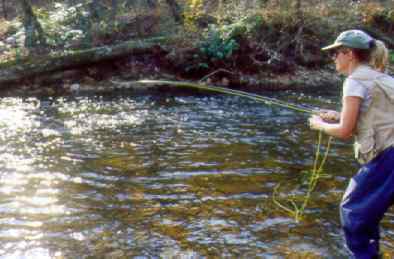 Fishing
for Trout
Fishing
for Trout Fishing for trout on the Chattahoochee is a popular pastime. Fishing, in general, is the most popular wildlife related activity in Georgia, enjoyed by over 1.15 million anglers representing every age group. The state's diverse freshwater fishery resources include over 4,000 miles of trout streams.
While the majority of the fishing pressure is centered below Buford Dam, a fair amount is also experienced in Helen especially on weekends in the fall and spring. Not until they go above Helen can anglers expect to find a private section of the Chattahoochee, and then there are fewer trout.
Anglers fish for browns, brooks, and rainbows primarily in the spring and fall, except for streams with year-round access. Because of the trouts' preference for insects, many anglers try to "match the hatch" of the species of insect found in the area they are fishing. In other words, they try to use a man-made fly that most closely resembles the type of insect hatching and seen on the water's surface the day they happen to be fishing. Fly-fishing guide Chris Scalley takes this approach with his clients.
"After they've been with me and had success in matching the hatch-matching the fly in the box to insects in the river, like you would if you were out West-they learn about the whole concept of aquatic insects and trout fishing," he said.
Scalley began a foundation in February 1998 known officially as the Chattahoochee Cold Water Tailrace Fishery Foundation Inc. to help protect the trout fishery.
"I've become more and more of a stakeholder in the river after six years of guiding," Scalley noted. "Basically they [fisheries managers] just dump fish in and people take them out, a put-and-take fishery. I want to see more credit given to the Chattahoochee as a trout fishery."
In order for the river to achieve recognition, some basic research must be done to determine how healthy the ecosystem is. That includes monitoring the water quality of the watershed.
Insects are the focus of the foundation's study because they represent the basis of the food chain for trout. The most common insects found on the Chattahoochee River are stoneflies, mayflies, midges and caddis flies-the most abundant insect on the river.
"Stoneflies are a real indicator because they are very sensitive to water quality. It's great news that we have stoneflies on the Chattahoochee," said Scalley.
There is some cause for concern, however, that insect populations may be disappearing because of nonpoint-source pollution such as runoff from golf courses, parking areas, lawns, and rooftops. If not stopped, this could eventually have a detrimental effect on trout populations.
"Water quality is in decline, and there's no question that with the landscape changing, the river will also change. We're just not sure of the impact it will have," said Scalley.
Klein has been very involved with Scalley's foundation project and helped Scalley narrow the foundation's mission to studying the invertebrates. According to Klein, there has been no invertebrate research conducted on the main channel of the river. In fact, the last invertebrate study by the DNR was conducted in 1960. The only related study is organized by the U.S. Geological Survey in some of the river's tributary streams and is currently ongoing. The Tennessee Valley Authority has also been doing similar studies, tracking pH, oxygen, and temperature levels and getting an overall rating of the tailwater.
"[The foundation's] study focuses on the Upper Chattahoochee River.centering on the stretch of river below Buford Dam to Island Ford and eventually including the area between Morgan Falls to Peachtree Creek," said Klein. "We want to get a good handle on what kind of macroinvertebrates are there, in terms of both numbers and the types of species there."
Preliminary monitoring on the Chattahoochee has already begun providing qualitative results. Hester Dendy samples provide colonies of insects that can be studied by researchers seasonally in various locations along the river. The sampling equipment looks like nothing more than a few pieces of substrate connected together. Several samples are placed in each location in case one of them is damaged or lost in the current. When the samples are pulled out of the water, insects can be found clinging to the pieces of substrate. These insects are counted and identified to various insect orders. Knowing the different types of orders of the insects will be enough to give them a good idea of the types of insect populations in the river. A growing list of volunteers, approximately 50 currently, aid in this effort.
The water quality issues facing the river may eventually take their toll on the trout fishery. Water temperature, pollution, and development along the river's corridor all have an effect on the river and the trout that call it home.
The Georgia Wildlife Federation is at work on the Chattahoochee River helping to maintain its trout fishery. GWF President Jerry McCollum believes keeping the Chattahoochee healthy for trout is good for humans, too. He says, "I think there is real value in maintaining the trout fishery in Atlanta because if we can keep the river clean enough for trout, it will be clean enough for drinking water without expensive pretreatment. Trout fishermen are some of the most staunch advocates of water quality and recognize the value of the entire river."
Two other organizations play a leading role in the protection of the river and the trout fishery: the Upper Chattahoochee Riverkeeper and Trout Unlimited (TU).
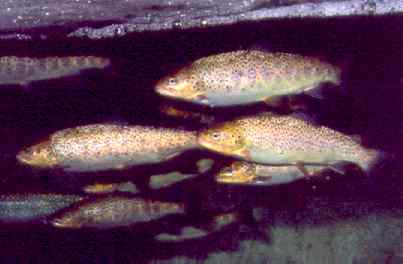 The
focus of the Riverkeeper is the protection of the river and its tributaries.
Established in 1994, the Riverkeeper is involved in aggressive legal and educational
initiatives to benefit the river. Most recent efforts have been centered on
sedimentation and temperature control of the river.
The
focus of the Riverkeeper is the protection of the river and its tributaries.
Established in 1994, the Riverkeeper is involved in aggressive legal and educational
initiatives to benefit the river. Most recent efforts have been centered on
sedimentation and temperature control of the river.
"One of the top issues is the hemorrhaging of Georgia soil into the river. The sediment is destroying the habitat of the trout fishery," said Sally Bethea, the Upper Chattahoochee Riverkeeper.
The effect of sediment on the trout is at least threefold. The sediment can clog the gills of the trout suffocating them, or it may cloud the water so the fish can't see and find food. In addition, it can cover the gravel beds that these fish utilize for spawning. Siltation also affects the river itself. Sediment can ultimately change the hydrology of the river. Buildup of sediment can cause areas of the river to become shallower, which also results in an increase in water temperature, eventually leading to dramatic effects on the trout fishery.
The temperature of the river is also an important issue because even the slightest changes can produce detrimental effects. Storm water runoff from parking areas and other types of development can greatly alter the temperature of the river. In summer months when rain water flows off rooftops and parking areas into the river, the cool river can be flooded with an onrush of warm water. Last May a study revealed a nine-hour increase in the river's temperature in one location that increased from 63 degrees to nearly 81 degrees Fahrenheit. Trout cannot survive these dramatic fluctuations in water temperature. "Once the water reaches a certain temperature they will die," said Klein.
The Riverkeeper is working with local governments to implement erosion and storm water ordinances that would help prevent this from happening.
These issues are not restricted to the section of river below Buford Dam but extend up into north Georgia, as well. More and more people are beginning to move into the mountains, resulting in an increase of development. As a result, sedimentation is a big issue in the headwaters region where small creeks can be completely silted in from nearby construction. Problems are found on Lake Lanier, too, where the Riverkeeper has found coves and tributaries silted in during boat patrols of the area.
Jerry McCollum serves on a trout stream buffer committee established in 1998 by the Georgia legislature. He says he is part of the group of committee members trying to maintain and create buffers on all trout streams while other committee members believe establishing the buffers constitutes a "taking" of mountain property and is unfair to mountain property owners and developers. The committee is working hard to resolve the issue.
McCollum says, "Trout stream buffers are critically important to the existence of trout in trout waters. They protect the temperature and quality of the water. When you remove the buffers, there is no way to filter runoff and water temperatures can increase by 2 to 3 degrees Fahrenheit, which is all it takes to kill trout."
Golf courses are a source of nonpoint-source pollution that is also affecting the headwaters according to Harris of Unicoi Outfitters. Harris has also seen one of the negative effects of the tubing outfitters that operate in Helen during the summer. So much trash comes downstream from the tubers that there is enough to fill up a pick-up truck bed each week, which Harris does every Monday in those hot months.
One of the more critical issues for the Riverkeeper, however, is the tri-state negotiations over the Apalachicola-Chattahoochee-Flint (ACF) basin. A "water war" is underway to determine how much water will be diverted to accommodate the needs of Georgia, Alabama, and Florida who share the river basin.
"We are very concerned that the in-stream flow in the Chattahoochee will not be adequate to maintain the trout fishery into the next millennium, given how Georgia is trying to negotiate. You have got to have certain in-stream flows for the critters there," said Bethea.
Many biologists and wildlife managers share the Riverkeeper's concerns of the tri-state water wars believing that not enough attention is given to maintaining the biodiversity in the river.
TU, a national organization dedicated to the conservation, protection, and restoration of North America's trout and salmon fisheries and their watersheds, is also a bit concerned about the allocation changes Georgia is proposing for the ACF basin.
Greg Moran, who is the Georgia Council representative for the organization, believes the allocation of the water is based more on development needs for Atlanta than for water, recreation, and health needs of the river.
The cause for concern is that the allocation changes would affect the releases at Buford Dam. If too little water is released, the water level will be insufficient to sustain the trout fishery.
The number one issues for TU in Georgia, however, are the same as that of the Riverkeeper: development and erosion sedimentation, and their impacts on the watershed.
While TU is not opposed to growth, they believe that the rate of development needs to be looked at and addressed. They are also in favor of implementing new regulations and educating developers so that sediment can be prevented from making its way into the river.
"It's just like they flushed the toilet, with all the development going up along the corridor of the Chattahoochee. Vegetation that grows on the rocks has been scoured away over the past 10 years," said Moran.
One issue that pales in light of the ACF allocation controversy for the Riverkeeper, but is very important to TU and some fisheries biologists is the possibility of another 40 million gallons of treated wastewater being dumped into Lanier each year. Because wastewater dumped in the lake is typically 25 degrees Fahrenheit warmer than the lake water, biologists are worried that the increase in water temperature in the lake will also increase the temperature of water coming out of the dam.
Currently, wastewater is dumped on the surface of the lake. When released on the surface, there is not as much of a temperature problem. Lake Lanier, like all other large lakes, has three layers of water: the bottom layer, known as the hypolimnion, the middle layer, or the thermlimnion, and the epilimnion or top layer. The middle layer is the most important, however, because this is the part of the water that changes temperature. This layer is located at maybe 30-40 feet deep in the lake.
Water is pulled from the bottom of Lake Lanier through Buford Dam. Wastewater dumped into the lower level of the lake could raise the temperature of the water that is pulled through and flows below Buford Dam. If water temperatures climb high enough, the trout fishery population would be in serious danger.
"How the lake [Lanier] looks in the future will affect the trout fishery," said Klein. "The more stuff you dump, the less likely you'll have a trout fishery."
Some of the changes in the river caused by what is going on at Lake Lanier are visible to the casual on-looker. Below Buford Dam, the river ranges in appearance from crystal clear to a pea-green color. A visit to the Buford Hatchery in the fall will give you a view of the river in its green stage. The river turns this green color in the fall because of changes in oxygen levels and water temperatures in Lake Lanier.
In the winter around January 1, Lanier has no layers, so the dissolved oxygen
is the same in all layers. By early spring, the top layer begins to warm up.
As temperatures continue to rise, this warm section of water begins to broaden
in size until it becomes thick enough to block the sunlight from reaching the
cool water on the bottom. When this occurs, the water no longer mixes between
the three layers, and the bottom layer no longer gets any oxygen. The dam pulls
water out of the lake from the bottom layer, so water taken by late summer has
very little oxygen. Because of the loss in oxygen, other chemical changes begin
to take place. Iron becomes soluble under high levels of oxygen but turns a
reddish color when oxidized.
Manganese is also soluble, which gives a greenish color to the river. As a result,
the river looks green in the fall, from September through mid-December or early
January, until the water layers all begin to cool and mix, changing the composition
once again.
Luckily, the first set of shoals, which are situated below Buford Dam at Bowman's Island, add oxygen back into the water as the river falls over the rocks. So regardless of the amount of oxygen in the water coming out of the dam, oxygen levels recover by the time it gets 5 to 6 miles downstream to the waiting trout population. The state standard for oxygen levels for trout is six parts oxygen per million.
The many issues affecting the Chattahoochee River have made it one of the top 10 endangered rivers in the country, according to American Rivers, which evaluates North America's rivers on an annual basis.
"There are more rivers that are more significantly regulated with dams and have more industrial pollution but I'm not sure there is another river that is trying to serve 3 million people with drinking water and that is so stressed by a growing metro area with no restraints for its growth," said Bethea. "And because the city is so high up in the river basin, the stream we are drawing water from is almost a trickle."
The number of people to be served by the Chattahoochee is projected to increase to 5 million over the next few years. Georgia is facing a critical water management issue that will not only affect the quality of life for Georgians, but the trout fishery itself.
"I don't see the situation changing in many years to come and maybe forever," said Moran.
Today, anglers continue to enjoy the thriving trout fishery in the Chattahoochee and throughout North Georgia. The trout population and the Chattahoochee itself offer a quality of life to Georgians that should not be taken for granted. Hopefully, the trout population and the water quality will be protected and improved so we can continue to benefit from this incredible resource.
Read and add comments about this page
Go back to previous page. Go to Chattahoochee River contents page. Go to Sherpa Guides home.
[ Previous Topic | Next Topic ]